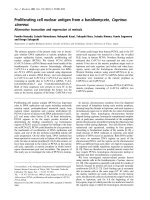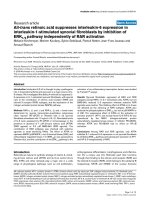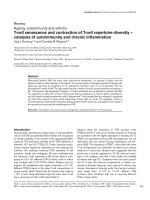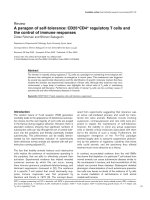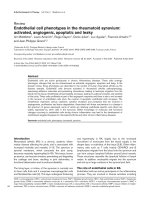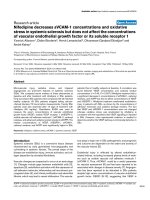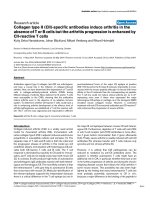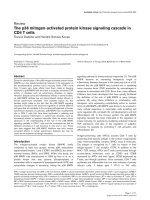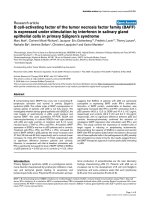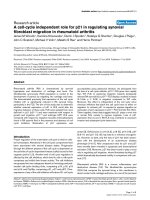Báo cáo y học: "T cell Activation does not drive CD4 decline in longitudinally followed HIV-infected Elite Controllers" docx
Bạn đang xem bản rút gọn của tài liệu. Xem và tải ngay bản đầy đủ của tài liệu tại đây (402 KB, 7 trang )
RESEARCH Open Access
T cell Activation does not drive CD4 decline
in longitudinally followed HIV-infected Elite
Controllers
Philomena Kamya
1,2
, Christos M Tsoukas
1,2,3
, Salix Boulet
1,2
, Jean-Pierre Routy
1,2,4
, Réjean Thomas
5
, Pierre Côté
6
,
Mohamed-Rachid Boulassel
4
, Bernard Lessard
6
, Rupert Kaul
7
, Mario Ostrowski
7
, Colin Kovacs
8
, Cecile L Tremblay
9
and Nicole F Bernard
1,2,3*
Abstract
Background: Elite controllers (EC) are a rare subset of HIV infected individuals who control viral load below
50 copies/ml of plasma without treatment.
Methods: Thirty four EC were studied. The slope of CD4 count change was available for 25 of these subjects.
We assessed immune activation by measuring the percent of CD38
+
HLA-DR
+
CD8
+
T cells in the EC group and
comparing it with that in 24 treatment-naïve HIV disease progressors and 13 HIV uninfected healthy controls.
Results: Compared to HIV uninfected subjects, EC had higher percentages of CD38
+
HLA-DR
+
CD8
+
T cells
(p < 0.001) that was lower than that observed in progressors (p < 0.01). Fifteen of 25 EC had a slope of CD4
count change that was not significantly different from 0 while 3 had a positive and 7 a negative CD4 count slope.
Immune activation did not distinguish EC subsets with stable/increasing versus declining CD4 counts.
Conclusions: Elevated immune activation in ECs is not associated with a faster rate of CD4 decline
Keywords: HIV infection, Elite controlle rs, activation markers, CD4 count change
Introduction
Untreated HIV infection is usually characterized by viral
replication and chronic generalized immune activ ation,
which is t hought to be an important driver of CD4
decline in HIV infection [1-6]. Markers of immune acti-
vation such as CD38 can be foun d on a high proportion
of the CD8
+
T cells in HIV infected individuals. CD38,
an ectoenzyme involved in transmembrane signaling
and cell adhesion, is ubiquitous in its distribution
among cells of the immune system and is a marker of
both activation and differentiation [7]. HLA-DR is a
human major histocompatability complex (MHC) class
II antigen that is expressed on macrophages, monocytes,
B cells and on activated T and NK cell s. The co-expres-
sion of CD38 and HLA-DR on CD8
+
T cells has been
used to detect immune activation in HIV infect ed
individuals with low-level viremia and to distinguish
populations that spontaneously control VL from those
successfully treated with anti-retroviral drugs [8,9].
While stimulation of the immune system by HIV
likely induces anti-viral immunity that plays a role in
suppress ion of viral replication, chronic immune acti va-
tion of non HIV-specific T cells reflects rapid cell turn-
over due to increased expansion and contraction of
antigen s timulated T cell clones [2]. This process leads
to CD4
+
T cell depletion and immune exhaustion
[4,8,10].
Less than 1% of those infected with HIV maintain VL
below the level measured by standard assays, i.e <50
copies/ml plasma, long term without treatment and are
called Elite Controllers (EC) or Elite Suppressors
[10-15]. Despite VL control some EC have low or
declining CD4 counts [8,9,14,16,17].
Here, we assessed the percent of CD38
+
DR
+
CD8
+
T
cells in 34 EC and compared these values to that seen
in chronically infected HIV progressors and uninfected
* Correspondence:
1
Research Institute of the McGill University Health Centre, Montréal, Québec,
Canada
Full list of author information is available at the end of the article
Kamya et al. AIDS Research and Therapy 2011, 8:20
/>© 2011 Kamya et al; licensee BioMed Central Ltd. This is an Open Access article distribute d under the terms of the Creative Common s
Attribution License ( which permi ts unres tricted use, distribution, and reproduction in
any medium, provided the original work is prop erly cited.
healthy controls. For 25 EC there were a sufficient num-
ber of longitudinally collected CD4 count determina-
tions to calculate the annual rate of CD4 count change.
Since immune activation is implicated in HIV disease
progression and varied among EC, w e questioned
whether EC with stable or increasing CD4 counts would
have lower immune activation levels than those with
declining CD4 counts.
We confirmed previous studies reporting abnormally
high immune activation levels among EC c ompared to
healthy uninfected contro ls and lower levels than seen is
HIV i nfected progressors in the chronic phase of infec-
tion [8,18,19]. We found t hat that immune activation
measures were similar in EC with stable/incr easing ver-
sus declining CD4 counts.
Materials and methods
Study population
The study po pulation included 58 untreated HIV-
infected individuals (34 EC, 24 progressors) and 13
HIV-negative healthy controls. Informed consent was
obtained from all participants and the research con-
formed to all ethical guidelines of the participating insti-
tutions. 28 EC were recruited from the Canadian
Cohort of HIV Infected Slow Progressors, which recruits
HIV-infected individuals from several community and
university-based hospital clinical centres in Canada; six
were from a cohort of HLA-B*57 positive EC followed
at the National Institutes of Health [12]. EC were
defined as having HIV RNA levels below the level of
detection by an ultrasensitive VL assay (<50 copies/mL)
on at least 3 oc casions for at least 1 year. VL was unde-
tectable at the time point immune activation was
assessed. HIV dise ase progressors were infected for at
least 1 year with evidence of declining CD4
+
Tcell
counts that fell below 500 cells/mm
3
and VL >10,000
copies/ml. None of the study subjects had evidence of
concurrent infections at the time immune activation was
assessed. For comparison, 13 healthy uninfected controls
were also studied.
Laboratory testing
Plasma viremia was measured using the Versant HIV-1
3.0 RNA assay (bDNA) (Bayer Diagnostics, Tarrytown,
NY) with a detection limit of 50 HIV-1 RNA copies/ml
of plasma.
Cells
Blood was obtained by either venipuncture into tubes
containing EDTA anticoagulant or by leukapheresis as
previously described [20]. Peripheral blood mononuclear
cells (PBMCs) were isolated by density gradient centrifu-
gation (Ficoll-paque, Pharmacia Uppsala, Sweden) and
cryopreserved in 10% dimethlyl sulfoxide (DMSO,
Sigma-Aldrich, St- Louis, MO) 90% fetal bovine serum
(FBS, Medicorps, Montreal, Quebec, Canada).
Flow Cytometry
Activation marker expression levels on T cells was mea-
sured on thawed PBMCs that were at least 80% viable by
staining with fluorescein isothiocyanate (FITC) conju-
gated anti-CD8, phycoerythrin (PE) conjugated anti-
CD38, allophycocyanin (AP C) conjugated anti-HLA-DR,
and peridinin chlorophyll protein (PerCP) anti-CD3 anti-
bodies (BD Biosciences, Mississauga, Canada) for 30 min-
utes in the dark. In parallel, control samples were stained
with PE- and APC-conjugated immunoglobulin isotype
control antibodies (BD Biosciences) and used to set gates
for defining positive staining. Analysis was performed on
a FACSCalibur instrument (BD Biosciences). At least
100,000 events were acquired and analyzed using FlowJo
software, version 8.8 (Tree Star, Inc, Ashland OR).
Statistics
GraphPad Prism software version 4.0a was used for gra-
phical presentation and GraphPad InStat version 3.06 for
statistical analysis. Mann-Whitney and Kruskal-Wallis
tests with Dunn’s multiple post-test comparisons were
used to assess the significance of between group differ-
ences for comparisons of 2 and more than 2 groups,
respectively. Linear regressio n was used to calculate CD4
count change. P-values <0.05 were considered significant.
Results
Study population
Table 1 provides information on age, CD4 count, CD8
counts and log
10
VL at the time at which percent CD38
+
DR
+
CD8
+
T cells were assessed for each of the EC par-
ticipants included in this study. It also presents informa-
tion on the number of CD4 count assessment and
follow up time used to calculate annual rate of CD4
count change with 95% confidence intervals (CI). In
most cases the duration of follow up for CD4 counts
and that for virological assessments was the same. Only
one s ubject, EC 11 who was followed for more than 16
years, lost viral control 9 years into follow up. All the
other EC subjects maintained VL <50 copies/ml of
plasma throughout follow up. Table 2 compares the
gender composition, median (range) age, CD4 count,
CD8 count, log
10
VL and duration of infection for the
EC group with th at of 24 HIV infected progressors. The
ECs and progressor groups were similar to each other in
age and absolute CD8 T cell counts (p > 0.05; Mann-
Whitney test). As expected based on the criteria used to
def ine the study populatio ns, EC had signifi cantly lower
log
10
VL and higher absolute CD4 counts compared to
progressors at the time of immune activation assessment
(p < 0.05 for both comparisons; Mann-Whitney test).
EC were infected for longer than progressors (p < 0.05;
Mann Whitney test). The control group of 13 healthy
controls included 9 males and 4 females aged a median
(range) of 27 (23, 51) yrs.
Kamya et al. AIDS Research and Therapy 2011, 8:20
/>Page 2 of 7
Assessment of immune activation in HIV-infected EC,
progressors and healthy controls
To address the reproducibili ty of the assessment of per-
cent CD38
+
DR
+
CD8
+
T cells we tested 6 time points
from the same HIV positive treatment naïve EC
individual in duplicate on 2 occa sions. The average
intra- and inter-assay coefficients of variation (CV) were
3.7% and 12.62%, respectively. The CV for this measure
determined 6 times over 3 years of follow up was 14.9%.
In contrast, the CV for percent CD38
+
DR
+
CD8
+
Tcells
Table 1 Elite Controller Study Population Characteristics
Subject
ID
Gender
1
Age
2
CD4
3
CD8
3
Duration of
infection
2
%CD38+DR
+CD8+
Duration CD4 FUP/VL
control
2,3
#CD4
assessments
Annual Rate of CD4
decline
4
EC 1 M 37 680 680 1 14.60 2.91 8 9.4 (-55.9,74.8)
EC 2 M 31 715 384 5 5.42 5.14 11 -17.7 (-56.2,20.8)
EC 3 M 68 660 1082 4 3.59 5.16 17 6.19 (-14.5,26.7)
EC 4 F 58 714 714 4 4.68 5.77 14 -6.73 (-50.7,37.2)
EC 5 M 53 310 730 6 3.95 5.27 14 -52.6 (-76.6,28.5)
EC 6 F 46 720 631 11 6.63 8.75 25 -7.4 (-22.7,8.0)
EC 7 M 37 1040 1095 11 4.33 9.64 22 14.4 (-6.5,35.3)
EC 8 F 40 737 303 12 7.11 12.08/14.52 22 -44.2 (-58.0,-30,4)
EC 9 M 53 800 288 10 7.35 14.88 35 15.9 (10.3,21.6)
EC 10 M 45 1050 1296 20 7.41 12.27 22 -11.2 (-27.9,5.4)
EC 11 M 39 689 455 9 10.20 16.78/9.12 86 -48.9 (-59.2,-38.6)
EC 12 F 33 728 434 10 2.36 17.30 79 -49.2 (-53.4,-45.0)
EC 13 M 47 770 1130 19 12.70 20.02/21.63 17 -33.0 (-50.6,-15.3)
EC 14 M 31 928 1566 2 20.00 2.75 N.A. N.A.
5
EC 15 F 31 442 816 2 12.40 4.75 4 15.8 (-19.3,50.9)
EC 16 F 60 800 1026 13 3.00 13.64 8 -5.3 (-58,7,58.0)
EC 17 M 40 460 307 4 6.35 3.87 10 4.3 (-40.9,49.6)
EC 18 M 42 870 551 1 8.27 1.50 N.A. N.A.
EC 19 F 30 692 627 6 10.10 2.17 6 -17.0 (-121.5,87.5)
EC 20 F 40 576 498 12 20.20 15.18/15.73 13 -30.9 (-50.2,-11.7)
EC 21 M 36 343 804 14 12.20 1.05 N.A. N.A.
EC 22 M 61 670 540 4 12.5 4.62 11 32.1 (-27.3,91.5)
EC 23 M 53 740 820 11 33.2 18.01 16 -15.1 (-33.3,3.0)
EC 24 M 41 978 787 1 37.3 11.24 29 -16.0 (-27.6,-4.4)
EC 25 M 55 990 680 10 15.3 9.48 16 -29.0 (-70.5, 12.5)
EC 26 M 68 970 400 17 17.5 13.18 19 14.5 (3.8,25.2)
EC 27 M 41 1200 860 11 13.9 12.39 34 28.6 (7.4,49.7)
EC 28 M 48 700 920 8 35.4 17.20 35 -1.4 (-5.0,2.1)
EC 29 F 53 499 202 8 28.9 N.A. N.A. N.A.
EC 30 M 40 510 1286 14 21.5 N.A. N.A. N.A.
EC 31 F 47 485 277 20 17.3 N.A. N.A. N.A.
EC 32 F 56 865 388 15 20.7 N.A. N.A. N.A.
EC 33 F 56 1488 1012 17 2.39 N.A. N.A. N.A.
EC 34 M 56 801 713 18 20.7 N.A. N.A. N.A.
1
M = male;F = female
2
years.
3
The duration of CD4 follow up/duration of viral load control if different from duration of CD4 follow up.
4
cells/mm
3
(95% confidence intervals).
5
Not available (insufficient information available to calculate a slope of CD4 counts change).
Table 2 Study population descriptive statistics
HIV-infected group Age (yrs)
1
Gender (M/F) CD4 count
1, 2
CD8 count
1,2
Log
10
VL
1
Duration of infection ( yrs)
1
EC (n = 34) 40 (30-68) 19/8 755 (310-1488) 696 (202-1286) 1.70 (1.70-1.70) 12.17 (1-20)
Progressors (n = 24) 36 (24-52) 22/3 314 (191-480) 710 (113-2260) 4.29 (2.51-5.91) 2 (2-12)
M = Male, F = Female, EC = Elite Controllers.
1
= Median (range).
2
= cells/mm
3
.
Kamya et al. AIDS Research and Therapy 2011, 8:20
/>Page 3 of 7
observed among the individuals in the EC and progres-
sor groups was 67.5% and 65.4%, respectively. Therefore,
the intra- and inter-assay variability for assessment of
this immune activation parameter did not exceed 13%
providing a measure of the reproduci bility of this
immune activation parameter within and between
experiments. The variabi lity of this immune activation
marker within a study subject followed 6 times over 3
years was less than the variability observed among unre-
lated HIV infected EC or progressors confirming the
notion of an immune activation set point introduced by
Deeks et al [10].
Figure 1 shows a scatter plot displaying the distribu-
tion of the percent of CD38
+
DR
+
CD8
+
T cells in the 3
study groups. Healthy c ontrols, EC and HIV infected
progressors had a median (range) of percent CD38
+
DR
+
CD8
+
T cells of 2.83 (0.9, 7.3), 12.6 (2.3, 37.3) and 39.8
(2.87, 77.4), respectively. Levels of this marker were sig-
nificantlyhigherinECthaninhealthycontrolsand
lowerthaninprogressors(p<0.01andp<0.001for
both comparisons; Dunn’s multiple comparisons test).
EC with declining CD4 counts do not have higher levels
of percent CD38
+
DR
+
CD8
+
T cells than those with stable/
increasing CD4 counts
Previous studies have proposed immune activation to be
an important driver of CD4 decline [2,21]. Twenty-five
EC were followed longitudinally for a minimum of 2
years with at least 4 CD4 count determinations. We
used this information to calculate their annual rate of
CD4 count change. T he median (range) number of CD4
determinations per subject was 18 (4, 86) taken over 10
(1, 20) yrs. Overall, the rate of CD4 count change was
-6.04 (-48.9, 32.1) (Table 1). Since longitudinal CD4
count determinations for any one patient are not linear
and biological fluctuations in CD4 count occur, leading
to wide 95% CI for CD4 count slopes within any given
patient, we categorized all CD4 count slopes having a
95% CI that crossed zero as not significantly different
from zero or stable. According to this criterion 15 EC
had stable CD4 count slopes, 3 had CD4 count slopes
that increased and 7 that declined significantly. Figure 2
shows graphs plotting the CD4 count change for the 10
subjects with either increasing (Figure 2A) or decreasing
(Figure 2B) annual CD4 slopes. Since the EC group
described here exhibited higher immune activation levels
than healthy controls, we questioned whether E C with
declining CD4 counts would have higher immune acti-
vation levels than those with stable or increasing CD4
count slopes. The percent of CD38
+
DR
+
CD8
+
T cells
for EC with declining and stable/increasing CD4 count
slopes was 8.8 (3, 35.4) and 10.2 (2.4, 37.3) (p = 0.92,
Mann-Whitney test) (Figure 3). Therefore, EC with fall-
ing CD4 counts were indistinguishable from those with
stable/increasing CD4 counts with re spect to this mea-
sure of immune activation.
Figure 1 Distribution of CD8
+
T cell activation markers among HIV uninfected healthy controls, HIV infected Elite Controllers (EC) and
HIV infected progressors. Shown is a scatter plot of the percent of CD38
+
DR
+
CD8
+
T cells in healthy controls (HIN-neg), HIV-infected EC (EC)
and progressors (PROG). The line through each scatter plot indicates the median value for the group. The significance of between-group
activation marker levels was assessed by comparing EC with healthy controls and with HIV infected progressors using a Kruskal-Wallis test with
Dunn’s multiple post-test comparisons. P-values shown correspond to comparisons performed between the 2 groups linked by the line under
the p-values.
Kamya et al. AIDS Research and Therapy 2011, 8:20
/>Page 4 of 7
Discussion
We confirmed previous reports of elevated levels of CD8
+
T cell immune activation among EC compare d to
healthy uninfected subjects [8,16]. EC with a declining
CD4 counts did not have elevated percent CD8
+
DR
+
CD8
+
T cell levels compared to those with stable or
increasing CD4 counts.
High T-cell activation levels predict more rapid dis-
ease progression in untreated HIV infecte d individuals
and decreased treatment mediated gains during anti-ret-
roviral therapy independentofplasmaHIVRNAlevels
[4,5,22-24]. The cor relation between HIV VL and
immune activation has made it difficult to resolve the
relative contributions of immune activation indepen-
dently of viremia on disease progression. A lthough
spontaneous control of viremia predicts slower HIV dis-
ease progression, VL alone only explains a fraction of
the variability in rate of HIV disease progression [25].
Even in EC, undetectable VL is not always accompa-
nied by maintenance of CD4 counts above 500 cells/
mm
3
and a stable CD4 count slope, suggesting that
some EC are exhibiting evidence of HIV disease pro-
gression [8,9,13,14,16,26,26,27]. We hypothesized that in
a setting of controlled viremia it would be possible to
determine whether immune activation is driving the rate
of CD4 count change. Although there have been several
reports of EC exhibiting low or declining CD4 counts
despite VL control to below the limit of detection of
standard assays, the cross sectional nature of some of
these analyses [8], small sample size [9,16,26] and failure
to take 95% CI into consideration in assigning a negative
value to the slope of CD4 count change [14,27] may
have limited their ability to determine whether immune
activation is driving CD4 decline. The results presented
here add to this body of knowledge by reporting that in
a group of 25 EC with a median (range) follow up time
Figure 2 Rate of CD4 decline in Elite Controllers with stable /increasing and declining annual rates of CD4 decline. Each graph shows
longitudinal absolute CD4 count determinations obtained through the period each study subject was followed. Time from start of follow up at
which CD4 counts were assessed is shown on the x-axis, while the absolute CD4 count in cells/mm
3
is shown on the y-axis. Panel A show
results for the 3 subjects with positive CD4 count slopes and B the 7 subjects with negative CD4 count slopes. The trend line through the points
describes the annual slope of CD4 count change, which is also written over each graph. The arrows in each graph indicate the time from start
of follow up at which immune activation was measured.
Kamya et al. AIDS Research and Therapy 2011, 8:20
/>Page 5 of 7
of 10 (1,20) yrs and 18 (4,86) CD4 count determinations
7 (28%) EC exhibited a negative slope of CD4 count
change. Since those with declining CD4 c ounts did not
have higher levels of immune activation than those with
stable or increasing CD4 counts our result s support the
interpretation that the level of immune activation as
determined by the percent of CD38
+
DR
+
CD8
+
Tcell
levels is not high enough in EC to drive CD4 decline.
Recently, it has been observed that most EC have low-
level viremia detected by assays that are more sensitive
than the standard VL assays [27-29]. A limitation of the
results reported here is that we do not have access to suf-
ficient volumes of plasma from these subjects to obtain
information on VL levels using more sensitive assays
detecting VL levels below 50 copies/ml plasma to address
this point. Therefore we cannot rule out that low level
VL may be a determinant of immune activation as mea-
sured by assessment of percent CD38
+
DR
+
CD8
+
T cells.
In summary, despite VL control, EC have higher CD8
+
T cell activat ion levels than uninfected healthy controls.
Some EC have declining CD4 counts and thus appear to
be exhibiting HIV disease progression. Immune activa-
tion as determin ed by pe rcent CD38
+
HLA-DR
+
CD8
+
T
cell levels in not higher in the EC subset with falli ng
CD4 counts.
Acknowledgements
The authors wish to thank the study participants of the Montreal Slow
Progressor and Primary Infection cohorts and Mr. Mario Legault and Ms
Stephanie Matte, the coordinators for these respective cohorts. We also
thank Drs. Joe Cox, Julian Falutz, Danielle Legault, Danielle Longpré, Danielle
Rouleau, Martin Potter, Richard Lalonde, John MacLeod, Marina Klein, Serge
Dufresne, Marc-André Charron. Michel Boissonnault, Sylvie Vézina, Annie
Talbot, Mark Connors and Stephen Migueles who recruited and followed
participants included in this study. We acknowledge the expert technical
support of Ms. Marie-Pierre Boisvert, Ms. Nancy Simic, Mr. Saied Sharafi and
Mr. Benjamin Tallon. This work was funded by the Réseau du SIDA et
Maladies Infectueuses du Fonds de Recherche en Santé du Québec (FRSQ)
and by a grant from the Canadian Institutes for Health Research #HOP-
86862. SB was supported by a Ph.D scholarship from the FRSQ and J-P
Routy is a scientific scholar receiving support from FRSQ.
Author details
1
Research Institute of the McGill University Health Centre, Montréal, Québec,
Canada.
2
Division of Experimental Medicine, McGill University, Montréal,
Québec, Canada.
3
Division of Clinical Immunology and Allergy, McGill
University Health Centre, Montréal, Québec, Canada.
4
Immunodeficiency
Service and Division of Hematology, Royal Victoria Hospital, McGill University
Health Center, Montreal, Quebec, Canada.
5
Clinique L’Actuel, Montréal,
Québec, Canada.
6
Clinique du Quartier Latin, Montréal, Québec, Canada.
7
Clinical Sciences Division and Department of Medicine, University of
Toronto, Toronto, Ontario, Canada.
8
Maple Leaf Clinic, Toronto, ON, Canada.
9
Centre de Recherche du Centre Hospitalier de l’Université de Montréal,
Montréal, Québec, Canada.
Authors’ contributions
PK designed the study, designed and optimized the antibody panel,
performed the experiments, analyzed the data and prepared the manuscript.
CMT and SB aided in study design, and critical review of manuscript. CMS,
JPR, RT, PC, MRB, BL, RK, MO, CC, and CT followed the Elite controller
subjects clinically and provided samples for this study. NFB designed the
study and prepared manuscript.
All authors have read and approved the final manuscript.
Competing interests
The authors declare that they have no competing interests.
Received: 18 April 2011 Accepted: 16 June 2011
Published: 16 June 2011
References
1. Giorgi JV, Lyles RH, Matud JL, et al: Predictive value of immunologic and
virologic markers after long or short duration of HIV-1 infection. J Acquir
Immune Defic Syndr 2002, 29(4):346-55.
2. Grossman Z, Meier-Schellersheim M, Sousa AE, Victorino RM, Paul WE: CD4+
T-cell depletion in HIV infection: are we closer to understanding the
cause? Nat Med 2002, 8(4):319-23.
3. Giorgi JV, Hultin LE, McKeating JA, et al: Shorter survival in advanced
human immunodeficiency virus type 1 infection is more closely
associated with T lymphocyte activation than with plasma virus burden
or virus chemokine coreceptor usage. J Infect Dis 1999, 179(4):859-70.
4. Liu Z, Cumberland WG, Hultin LE, Kaplan AH, Detels R, Giorgi JV: CD8+ T-
lymphocyte activation in HIV-1 disease reflects an aspect of
pathogenesis distinct from viral burden and immunodeficiency. J Acquir
Immune Defic Syndr Hum Retrovirol 1998, 18(4):332-40.
5. Liu Z, Cumberland WG, Hultin LE, Prince HE, Detels R, Giorgi JV: Elevated
CD38 antigen expression on CD8+ T cells is a stronger marker for the
risk of chronic HIV disease progression to AIDS and death in the
Multicenter AIDS Cohort Study than CD4+ cell count, soluble immune
activation markers, or combinations of HLA-DR and CD38 expression. J
Acquir Immune Defic Syndr Hum Retrovirol 1997, 16(2):83-92.
6. Deeks SG, Kitchen CM, Liu L, et al: Immune activation set point during
early HIV infection predicts subsequent CD4+ T-cell changes
independent of viral load. Blood 2004, 104(4):942-7.
7. Deaglio S, Mehta K, Malavasi F: Human CD38: a (r)evolutionary story of
enzymes and receptors. Leuk Res 2001, 25(1):1-12.
8. Hunt PW, Brenchley J, Sinclair E, et al: Relationship between T cell
activation and CD4+ T cell count in HIV-seropositive individuals with
undetectable plasma HIV RNA levels in the absence of therapy. J Infect
Dis 2008, 197(1):126-33.
Figure 3 Percent of CD38
+
DR
+
CD8
+
T cells does not distinguish
Elite Controllers with stable/increasing versus declining CD4
counts. Shown is a scatter plot comparing the percent of CD38
+
HLA-DR
+
CD8
+
T cells in the EC group with stable or increasing
versus decreasing CD4 counts. The bar through each scatter plot
indicates the median value for the group. P-values shown
correspond to between-group comparisons performed using a
Mann-Whitney test.
Kamya et al. AIDS Research and Therapy 2011, 8:20
/>Page 6 of 7
9. Sedaghat AR, Rastegar DA, O’Connell KA, Dinoso JB, Wilke CO, Blankson JN:
T cell dynamics and the response to HAART in a cohort of HIV-1-
infected elite suppressors. Clin Infect Dis 2009, 49(11):1763-6.
10. Deeks SG, Walker BD: Human immunodeficiency virus controllers:
mechanisms of durable virus control in the absence of antiretroviral
therapy. Immunity 2007, 27(3):406-16.
11. Lambotte O, Boufassa F, Madec Y, et al: HIV controllers: a homogeneous
group of HIV-1-infected patients with spontaneous control of viral
replication. Clin Infect Dis 2005, 41(7):1053-6.
12. Migueles SA, Sabbaghian MS, Shupert WL, et al: HLA B*5701 is highly
associated with restriction of virus replication in a subgroup of HIV-
infected long term nonprogressors. Proc Natl Acad Sci USA 2000,
97(6):2709-14.
13. Okulicz JF, Marconi VC, Landrum ML, et al: Clinical outcomes of elite
controllers, viremic controllers, and long-term nonprogressors in the US
Department of Defense HIV natural history study. J Infect Dis 2009,
200(11):1714-23.
14. Madec Y, Boufassa F, Porter K, Meyer L: Spontaneous control of viral load
and CD4 cell count progression among HIV-1 seroconverters. AIDS 2005,
19(17):2001-7.
15. Grabar S, Selinger-Leneman H, Abgrall S, Pialoux G, Weiss L, Costagliola D:
Prevalence and comparative characteristics of long-term nonprogressors
and HIV controller patients in the French Hospital Database on HIV. AIDS
2009, 23(9):1163-9.
16. Andrade A, Bailey JR, Xu J, et al: CD4+ T cell depletion in an untreated
HIV type 1-infected human leukocyte antigen-B*5801-positive patient
with an undetectable viral load. Clin Infect Dis 2008, 46(8):e78-e82.
17. Greenough TC, Sullivan JL, Desrosiers RC: Declining CD4 T-cell counts in a
person infected with nef-deleted HIV-1. N Engl J Med 1999, 340(3):236-7.
18. Saez-Cirion A, Lacabaratz C, Lambotte O, et al: HIV controllers exhibit
potent CD8 T cell capacity to suppress HIV infection ex vivo and
peculiar cytotoxic T lymphocyte activation phenotype. Proc Natl Acad Sci
USA 2007, 104(16):6776-81.
19. Andrade A, Bailey JR, Xu J, et al: CD4+ T cell depletion in an untreated
HIV type 1-infected human leukocyte antigen-B*5801-positive patient
with an undetectable viral load18. Clin Infect Dis 2008, 46(8):e78-e82.
20. Boulassel MR, Spurll G, Rouleau D, et al: Changes in immunological and
virological parameters in HIV-1 infected subjects following
leukapheresis. J Clin Apher 2003,
18(2):55-60.
21. Sousa AE, Carneiro J, Meier-Schellersheim M, Grossman Z, Victorino RM:
CD4 T cell depletion is linked directly to immune activation in the
pathogenesis of HIV-1 and HIV-2 but only indirectly to the viral load. J
Immunol 2002, 169(6):3400-6.
22. Gandhi RT, Spritzler J, Chan E, et al: Effect of baseline- and treatment-
related factors on immunologic recovery after initiation of antiretroviral
therapy in HIV-1-positive subjects: results from ACTG 384. J Acquir
Immune Defic Syndr 2006(4):426-34.
23. Goicoechea M, Smith DM, Liu L, et al: Determinants of CD4+ T cell
recovery during suppressive antiretroviral therapy: association of
immune activation, T cell maturation markers, and cellular HIV-1 DNA. J
Infect Dis 2006, 194(1):29-37.
24. Hunt PW, Martin JN, Sinclair E, et al: T cell activation is associated with
lower CD4+ T cell gains in human immunodeficiency virus-infected
patients with sustained viral suppression during antiretroviral therapy. J
Infect Dis 2003, 187(10):1534-43.
25. Rodriguez B, Sethi AK, Cheruvu VK, et al: Predictive value of plasma HIV
RNA level on rate of CD4 T-cell decline in untreated HIV infection. JAMA
2006, 296(12):1498-506.
26. Greenough TC, Sullivan JL, Desrosiers RC: Declining CD4 T-cell counts in a
person infected with nef-deleted HIV-1. N Engl J Med 1999, 340(3):236-7.
27. Pereyra F, Palmer S, Miura T, et al: Persistent low-level viremia in HIV-1
elite controllers and relationship to immunologic parameters. J Infect Dis
2009, 200(6):984-90.
28. Dinoso JB, Kim SY, Siliciano RF, Blankson JN: A comparison of viral loads
between HIV-1-infected elite suppressors and individuals who receive
suppressive highly active antiretroviral therapy. Clin Infect Dis 2008,
47(1):102-4.
29. Hatano H, Delwart EL, Norris PJ, et al: Evidence for persistent low-level
viremia in individuals who control human immunodeficiency virus in
the absence of antiretroviral therapy. J Virol 2009, 83(1):329-35.
doi:10.1186/1742-6405-8-20
Cite this article as: Kamya et al.: T cell Activation does not drive CD4
decline in longitudinally followed HIV-infected Elite Controllers. AIDS
Research and Therapy 2011 8:20.
Submit your next manuscript to BioMed Central
and take full advantage of:
• Convenient online submission
• Thorough peer review
• No space constraints or color figure charges
• Immediate publication on acceptance
• Inclusion in PubMed, CAS, Scopus and Google Scholar
• Research which is freely available for redistribution
Submit your manuscript at
www.biomedcentral.com/submit
Kamya et al. AIDS Research and Therapy 2011, 8:20
/>Page 7 of 7
